Abstract
Blood platelets play a crucial role in hemostasis, the process responsible for keeping blood flowing in the circulatory system. However, unnecessary platelet activation can lead to aggregation at the site of atherosclerotic plaque rapture and the formation of a thrombus, which promotes atherothrombotic diseases. Various dietary components, such as phenolic compounds, are known to demonstrate antiplatelet and anticoagulant properties, and it is possible that these could form an important element in the prophylaxis and therapy of cardiovascular diseases. Our present study examined the biological activity of isorhamnetin (1) and two isorhamnetin derivatives, (2): 3-O-beta-glucoside-7-O-alpha-rhamnoside and (3): 3-O-beta-glucoside-7-O-alpha-(3″′-isovaleryl)-rhamnoside, isolated from the phenolic fraction of sea buckthorn fruit, against human washed blood platelets and human whole blood in vitro. The anti-platelet and anticoagulant potential was determined using (A) flow cytometry, (B) the thrombus-formation analysis system (T-TAS) and (C) colorimetry. The results of the T-TAS test indicate that the AUC10 (Area Under the Curve) of the tested phenolic compounds (compounds 1, 2 and 3; 50 µg/mL) was markedly reduced compared to the control values. Moreover, flavonol demonstrated anti-platelet potential, including anti-adhesive activity, with these effects being more intense in compound 2 than isorhamnetin. Different actions of flavonol on platelet activation may depend on their binding ability to various receptors on blood platelets. However, the mechanism of their anti-platelet potential requires further additional studies, including in vitro and in vivo experiments.
1. Introduction
Blood platelets play a crucial role in hemostasis, a process responsible for keeping the blood flowing in the circulatory system. Platelets are generated from megakaryocytes in bone narrow, with daily production providing 150–400 × 109 platelets per liter of blood. The cells display a range of surface receptors and adhesion molecules, and contain numerous granules; these are used to initiate coagulation cascades in primary hemostasis, where blood platelets adhere to the extracellular matrix [1]. Platelet activation may be stimulated by platelet secretion products and local prothrombotic factors, including tissue factors. There are two main pathways leading to platelet activation, but both result in the rapid binding of platelets to damaged blood vessels.
Stable platelet adhesion requires an interaction between glycoprotein GPVI, integrin-α2β1, and collagen, and between integrin-α5β1 and fibronectin. The binding of collagen to GPVI results in platelet activation and the release of soluble agonists, including ADP and thromboxane A2, leading to the activation of GPIIb/IIIa, a major receptor for fibrinogen. As a result of this process, the platelets aggregate and form a thrombus [2]. However, unnecessary platelet activation can lead to the development of atherothrombotic diseases caused by aggregation and thrombus formation at the site of an atherosclerotic plaque rupture. The rupture of an atherosclerotic plaque or acute erosion of the endothelial layer can result in the formation of a pathological arterial thrombus, leading to the exposure of highly reactive subendothelial matrix proteins, such as collagen and von Willebrand factors (vWF) [1].
Arterial thrombosis is responsible for myocardial infraction and ischemic stroke, two of the leading causes of death globally. They are often treated pharmacologically with antiplatelet drugs, due to the fundamental role of blood platelets in the development of atherothrombosis [2].
Various in vitro and in vivo analyses indicate that certain dietary components with antiplatelet and anticoagulant properties, such as phenolic compounds, may also play a valuable role in the prophylaxis and therapy of cardiovascular diseases (CVDs) [3,4,5,6]. For example, isorhamnetin and two of its derivatives isolated from the phenolic fraction of sea buckthorn fruit, viz. 3-O-beta-glucoside-7-O-alpha-rhamnoside and 3-O-beta-glucoside-7-O-alpha-(3″′-isovaleryl)-rhamnoside, have been found to have antioxidant and anti-aggregation potential against washed blood platelets, and anticoagulant potential against plasma [4]; however, their mechanisms of action in whole blood remain poorly understood. Therefore, the aim of the present study was to determine the biological activity of isorhamnetin (compound 1), 3-O-beta-glucoside-7-O-alpha-rhamnoside (compound 2) and 3-O-beta-glucoside-7-O-alpha-(3″′-isovaleryl)-rhamnoside (compound 3), (Figure 1) using human washed blood platelets and human whole blood in vitro.
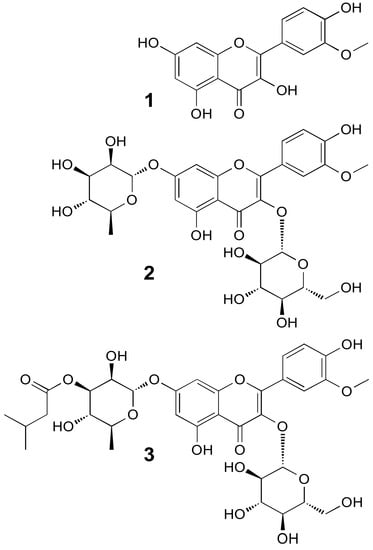
Figure 1.
Chemical structure of isorhamnetin (compound 1) and its derivatives: compound 2 (3-O-beta-glucoside-7-O-alpha-rhamnoside) and compound 3 (3-O-beta-glucoside-7-O-alpha-(3″′-isovaleryl)-rhamnoside) isolated from the phenolic fraction of E. rhamnoides (L.) A. Nelson fruits [4,7].
Isorhamnetin is a flavonol, representing one of the most important active ingredients in the fruit of Hippophae rhamnoides L., which has a broad pharmacological effect. Isorhamnetin and its derivatives have an effect on the protection of the circulatory system and cerebral vessels, with anti-cancer, anti-inflammatory, antioxidant, organ, anti-obesity effects, etc.
The anti-platelet and anticoagulant potential was evaluated using the following three key analytical approaches: (A) flow cytometry, by measuring the cell-surface exposition of P-selectin (CD62P) and the existence of the active form of GPIIb/IIIa (PAC-1 binding), which was performed in resting or agonist (ADP or collagen)-stimulated blood platelets after incubation with tested compounds and plant fraction; (B) the thrombus-formation analysis system (T-TAS), which was used to determine the influence of the tested compounds and plant fraction on thrombus formation in whole blood; (C) colorimetry, which was used to assess the changes of platelet adhesion to collagen after incubation with the tested compounds and plant fraction. The activity of the tested compounds and phenolic fraction was compared to that of a commercial product, Aronox (Aronia melanocarpa berry extract with anti-platelet properties) [8,9].
2. Results
The results of the T-TAS test indicate that the AUC10 of the tested phenolic compounds (compound 1, 2 and 3; 50 µg/mL) was markedly reduced compared to control values (Figure 2 and Figure 3).
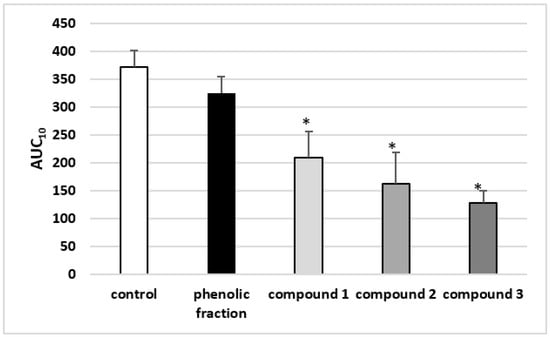
Figure 2.
Effects of isorhamnetin, its derivatives and the phenolic fraction of E. rhamnoides (L.) A. Nelson fruits (50 µg/mL; 30 min) on the T-TAS using the PL-chip in whole blood samples. Whole blood samples were analyzed by the T-TAS at the shear rates of 1000 s−1 on the PL-chips. The area under the curve (AUC10) in PL are shown. Data represent the means ± SD of six healthy volunteers. * p < 0.05 vs. control.
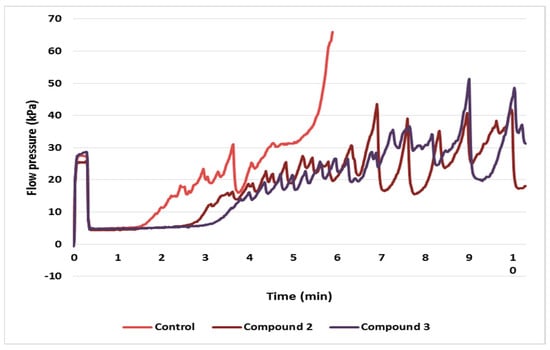
Figure 3.
Flow pressure analysis reflect the platelet thrombus formation process using the PL-chip in whole blood (control-blood treated without derivatives of isorhamnetin; blood treated with 50 µg/mL derivatives of isorhamnetin: compound 2 and 3 within 10 min.
Figure 3, Figure 4, Figure 5 and Figure 6 present the markers of blood platelet activation measures with flow cytometry. While changes in blood platelet activation were noted in whole blood treated with all the tested phenolic compounds (1–3) and the phenolic fraction from sea buckthorn fruits, these changes were not always statistically significant (Figure 3, Figure 4, Figure 5 and Figure 6). The significant inhibition of the exposition of P-selectin was observed only in the highest concentration (50 µg/mL) in compounds 2 and 3 in 10 µM ADP-activated blood platelets. In addition, at a concentration of 50 µg/mL, compound 2 significantly reduced the exposure of GPIIb/IIIa on blood platelets activated by 20 µM ADP or by collagen (Figure 3, Figure 4, Figure 5 and Figure 6).
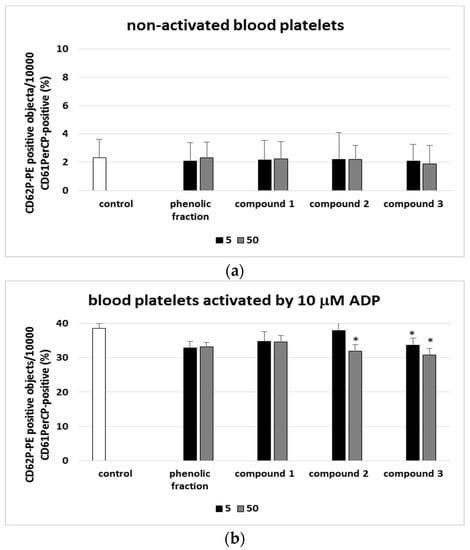
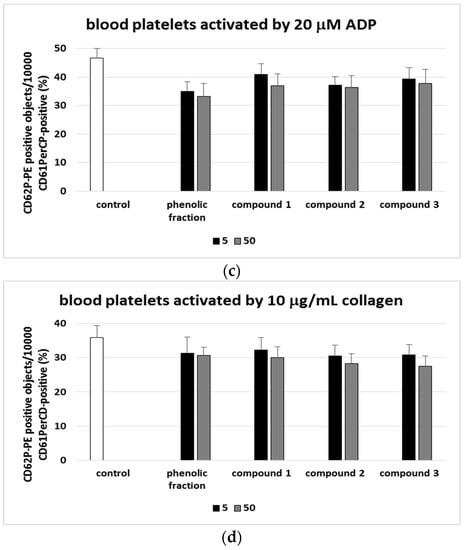
Figure 4.
Effects of isorhamnetin, its derivatives and the phenolic fraction of E. rhamnoides (L.) A. Nelson fruits (5 and 50 µg/mL; 30 min) on the exposure of P-selectin on resting (a) or agonist-stimulated blood platelets: 10 µM ADP (b), 20 µM ADP (c) and 10 µg/mL collagen (d) in whole blood samples. The blood platelets were distinguished based on the exposition of CD61/PerCP. For each sample, 10,000 CD61-positive objects (blood platelets) were acquired. For the assessment of P-selectin exposition, samples were labeled with fluorescently conjugated monoclonal antibody CD62P. Results are shown as the percentage of platelets expressing CD62P. Data represent the means ± SD of 5 healthy volunteers. * p < 0.05 vs. control.
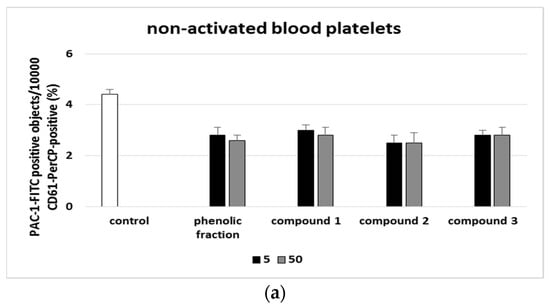
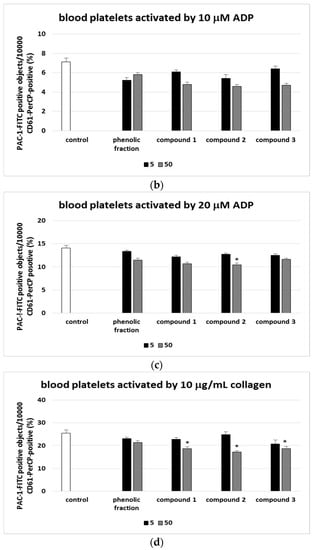
Figure 5.
Effects of isorhamnetin, its derivatives and the phenolic fraction of E. rhamnoides (L.) A. Nelson fruits (5 and 50 µg/mL; 30 min) on the exposure of the active form of GPIIb/IIIa on resting (a) or agonist-stimulated blood platelets: 10 µM ADP (b), 20 µM ADP (c) and 10 µg/mL collagen (d) in whole blood samples. The blood platelets were distinguished based on the exposition of CD61. For each sample, 10,000 CD61-positive objects (blood platelets) were acquired. For the assessment of GPIIb/IIIa exposition, samples were labeled with fluorescently conjugated monoclonal antibody PAC-1/FITC. Results are shown as the percentage of platelets binding PAC-1/FITC. Data represent the means ± SD of 5 healthy volunteers. * p < 0.05 vs. control.
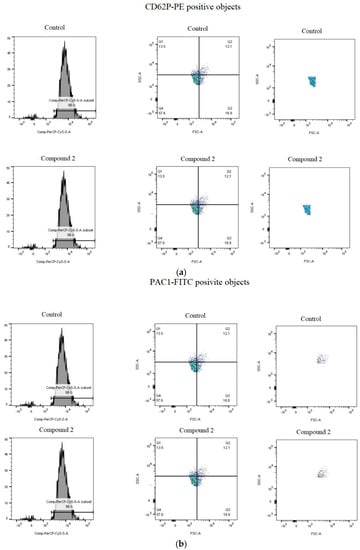
Figure 6.
Effects of compound 2 (50 µg/mL; 30 min) on the exposure of P-selectin (a) and the active form of GPIIb/IIIa (b) in platelets stimulated by 10 µg/mL collagen in whole blood samples. Figure demonstrates selected diagrams.
Additionally, the anti-adhesive activity of the phenolic fraction from sea buckthorn fruits and phenolic compounds (1–3) was studied. The non-activated blood platelets and thrombin-activated platelets demonstrated significantly lower collagen adhesion following incubation with compounds 1, 2, and 3 (5 and 50 µg/mL), as well as with the phenolic sea buckthorn fruit fraction (Figure 7).
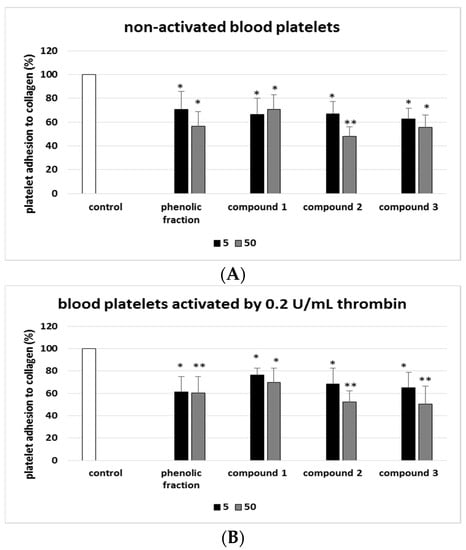
Figure 7.
Effects of isorhamnetin, its derivatives and the phenolic fraction of E. rhamnoides (L.) A. Nelson fruits (5 and 50 µg/mL; 30 min) on the collagen adhesion of resting (A) and thrombin-activated platelets (B). Blood platelets not treated with phenolic compounds/plant fraction were used as control samples (positive control). Adhesion is expressed as a percentage of the control samples (100%). Data represent means ± SD of six healthy volunteers (experiments performed in triplicate). Action of phenolic compounds and phenolic fraction was compared to control: * p < 0.05, ** p < 0.01.
Table 1 compares the effects of isorhamnetin and its derivatives (50 µg/mL) on hemostasis in whole blood and washed blood platelets.

Table 1.
Comparative effects of isorhamnetin and its derivatives (at 50 µg/mL) on parameters of hemostasis compared to control (whole blood or washed blood platelets without treated with phenolic compounds).
The strongest anti-platelet and anti-coagulant potential was demonstrated by compound 2, which inhibited the exposition of GPIIb/IIIa and P-selectin on blood platelets in whole blood. It also demonstrated anti-adhesion properties in washed blood platelets. Compound 2 demonstrated the strongest anti-adhesion effect of both non-activated and thrombin-activated platelets. Compound two also had anti-coagulant potential in whole blood, as measured by T-TAS. The lowest biological activity was demonstrated by compound 1, which demonstrated only anti-adhesive activity and anticoagulant activity, but did not have any effect on biomarkers of platelets activation measured by flow cytometry. The aronia berry extract (50 µg/mL, positive control) also showed anti-platelet activity, for example decreasing PAC-1 binding in blood platelets activated by 20 µM ADP and collagen; it also reduced the exposure of GPIIb/IIIa on blood platelets activated by 10 µM ADP, 20 µM ADP and collagen (data not presented).
3. Discussion
Four main classes of antiplatelet drugs are currently used in the therapy of cardiovascular diseases. The first type are cyclooxygenases 1 (COX1) inhibitors such as acetylsalicylic acid, which blocks thromboxane A2 production [2]. Other drugs are used to inhibit the P2Y12 receptors for ADP; these are divided into the following two groups: thienopyridines, such as clopidogrel, and nucleoside-nucleotide derivates, such as cangrelor. The third group comprises proteinase-activated receptor 1 (PAR1) antagonists such as vorapaxar, which was developed to target thrombin; the platelet reaction to thrombin is mainly mediated by the following two G protein-coupled PARs: PAR1 and PAR4. Finally, GPIIb/IIIa inhibitors can be used, such as abciximab, a human antigen-binding fragment of mouse monoclonal antibody, tirofiban, a nonpeptidic small molecule mimicking the fibrinogen binding site, and eptifibatide, a cyclic heptapeptide with lysine-glycine-aspartic acid and a motif mimicking the fibrinogen binding sequence within GPIIb/IIIa. Unfortunately, in numerous cases, the use of these drugs is connected with an elevated risk of bleeding [2].
It is known that phenolic compounds demonstrate a range of pro-health effects on the human body, including various anti-inflammatory, antilipidemic, antiviral and antibacterial, hepatoprotective and cardioprotective properties [10]. These properties allow them to be used as active ingredients in various nutraceutical, cosmetic and even pharmaceutical preparations, and can be found in red wine, tea, coffee and medical herbs, as well as in fruits and vegetables [10]. In addition, phenolic compounds, including flavonoids isolated from various parts of plants possess anti-platelet activity. For example, they may inhibit P-selectin exposition, which has a crucial role in the connection of inflammation and hemostasis. P-selectin is an integrin belonging to heterodimeric transmembrane receptors, formed by noncovalent association of α and β chains; its main role is to meditate interactions with adhesion molecules on other cells and extracellular matrix molecules [1].
Flavonols are a class of flavonoids that have the 3-hydroxyflavone backbone. Their diversity stems from the different positions of –OH groups. Isorhamnetin is a flavonol isolated from the leaves, flowers and fruits of E. rhamnoides, Ginkgo biloba and other plants. It shows a broad range of pharmacological activity against cardiovascular disease, tumors and some neurovegetative diseases, such as Alzheimer’s disease. Its therapeutic effect against cardiovascular and cerebrovascular diseases is based on its ability to protect endothelial cells, and its anti-atherosclerosis, anti-hypotension and anti-thrombosis activity [10,11]. It can also improve nerve function and enhance memory. It has also demonstrated a bacteriostatic effect and has been proposed as a candidate for antibacterial drug research [11]. Isorhamnetin has also demonstrated some anti-tumor effects, manifested in the inhibition of human cervical cancer cell, lung cancer cells, breast cancer cell and liver cancer cells. It inhibits the proliferation of tumor cells by inducing apoptosis and the regulation of tumor suppressor genes and signal pathways [10,11].
The anti-inflammatory effects of isorhamnetin derive from its ability to regulate the production of inflammatory mediators such as cytokines, and to inhibit the NF-ĸB (nuclear factor kappa-light-chain-enhancer of activated B cells) pathway, which regulates a range of inflammatory molecules; indeed, its influence on NF-κB signaling is known to protect endothelial cells against inflammation and oxidative damage [11]. Isorhamnetin has also been found to reduce the risk of thrombosis by inhibiting collagen-stimulated platelet aggregation and various aspects of signal transduction; in addition, similarly to all flavonoids, it has been found to demonstrate strong antioxidant activity by scavenging radicals and inhibiting lipid peroxidation [10]. Moreover, isorhamnetin can inhibit cardiac hypertrophy and fibrosis by blocking the activation of the phosphatidylinositol 3-kinase-AKT (protein kinase B) signaling pathway. In in vitro studies, isorhamnetin attenuated cardiomyocyte hypertrophy in neonatal rat cardiomyocytes induced by angiotensin II [11].
Flavonoids also show some cardiovascular activity; this is mostly connected with their antiplatelet activity, i.e., preventing primary clot formation and inhibiting platelet aggregation. A structure-activity analysis attributed this antiaggregatory activity to the C-ring structure of flavonoids, as non-methylated flavonoids with a double bond between C2 and C3 have the strongest antiaggregatory activity [10]. In addition, the antiplatelet activity of plants is often related to their flavonoid and phenolic content. The leaves from Melissa officinalis, whose main compounds are flavonoids, reduced ADP-induced platelet aggregation by up to 18% [12,13]. More details about biological properties, including pharmacological activity have been described by Gong et al. [11].
Sea buckthorn fruits have been found to be a safe and valuable source of phenolic compounds such as flavonoids. Isorhamnetin and two isorhamnetin derivatives, 3-O-beta-glucoside-7-O-alpha-rhamnoside (compound 2) and 3-O-beta-glucoside-7-O-alpha-(3″′-isovaleryl)-rhamnoside (compound 3), have been reported to have antioxidant, anti-platelet and anticoagulant properties against plasma and washed platelets in vitro [4]. The present study examined the effects of these three flavonoids (compounds 1–3) and a phenolic fraction from sea buckthorn fruits on selected aspects on hemostasis in whole blood. It is the first study to compare the effects of these three phenolic compounds on inhibiting thrombus formation and their anticoagulant properties in whole blood measured by T-TAS; this approach imitated in vivo conditions to assess whole blood thrombogenicity.
A significant role in clotting is played by GPIIb/IIIa signaling, with inside-out GPIIb/IIIa signaling being activated during platelet activation. However, ligand-bound GPIIb/IIIa can result in outside-in signaling events that mediate cytoskeletal reorganization. The initial arterial thrombus is reinforced by thrombin generation, which further increases platelet activation and activates coagulation, leading to greater stabilization of the fibrin mesh [2]. In the present study, compound 2 (50 µg/mL) was found to reduce GPIIb/IIIa exposition in platelets activated by 20 µM ADP. The GPIIb/IIIa complex is recognized by PAC-1, which promotes platelet aggregation. These findings suggest that the compound has an inhibitory effect on platelet aggregation. In addition, all the tested flavonoids (i.e., compounds 1–3) also inhibited the activation of platelets stimulated by collagen.
Compounds 2 and 3 also appeared to inhibit P-selectin exposition in stimulated platelets, again indicating anti-platelet activity. The tested flavonoids also inhibited the adhesion of washed platelets to collagen, as indicted colorimetrically. Compound 3 (50 µg/mL) showed the greatest anti-adhesive properties against thrombin-stimulated platelets. In addition, our earlier results reported that compound 3 has inhibitory action against thrombin-stimulated human blood platelet aggregation (using washed platelets). It may suggest that this compound could modulate platelet activation by interfering with thrombin receptors on platelets [4].
Previous studies have also found isorhamnetin to have strong antiplatelet potential. For example, isorhamnetin administered at 1–100 µM significantly inhibited platelet aggregation induced by collagen and thrombin receptor activator peptide [14]. It also reduced the level of ATP (adenosine triphosphate) in collagen-stimulated platelets [14]. Stainer et al. [15] also demonstrated the antithrombotic activity of isorhamnetin in in vitro studies. The analysis included biomarkers of platelets activation, such as P-selectin exposure, fibrinogen binding and aggregometry. Isorhamnetin inhibited the aggregation induced by collagen and binding platelets to fibrinogen. The obtained results confirmed the antithrombotic and anticoagulant activity of isorhamnetin [15]. Yun et al. [16] analyzed the anti-atherosclerosis effect of isorhamnetin isolated from Hippophae rhamnoides L. in an in vivo study. Six-week old male C57BL/6J mice were dived in four groups. Isorhamnetin in a dose of 20 mg/kg of body weight was orally administrated. The study included the analyses of atherosclerotic lesion macrophage accumulation and apoptosis and lipid levels in serum. The results demonstrated isorhamnetin’s ability to decrease the occurrence of macrophage-induced apoptosis in atherosclerotic lesions, which confirmed the protective effect of isorhamnetin on the cardiovascular system [16].
Compound 2 was found to demonstrate stronger anti-platelet and anti-coagulant potential than compound 3 and isorhamnetin in whole blood; these differences may be due to their chemical structure. Our earlier results also reported that compound 2 has stronger antioxidant activity than compound 3 and isorhamnetin [4]. The most significant innovative finding of our experiment is that the tested flavonoids often demonstrated similar, or stronger, anti-platelet and anti-coagulant properties than the whole phenolic fraction. In addition, it is important to note that the flavonoids and phenolic fraction were administered in two concentrations, 5 and 50 µg/mL, the lower of which may correspond to the physiological concentration of plant-derived phenolic compounds available after oral supplementation.
Although the study demonstrated anticoagulant and antiadhesive activity of the isorhamnetin derivate, there were some weak points. The obtained results demonstrated the antiadhesive activity in all the tested compounds; however, there was limited confirmation in the measurement of biomarkers of platelets’ activation. In addition, only two concentrations were tested, which does not reveal the full range of potential effects. The antiplatelet effect was observed only in a higher concentration, which limited the use of isorhamnetin in potential therapy with oral administration. The results presented in this study are promising, but more detailed research should be conducted.
Conclusions
An important and novel finding of the present study is that the flavonoids isolated from sea buckthorn fruits possess anticoagulant and anti-platelet (including anti-adhesive) potential against both washed blood platelets and whole blood. Of the tested compounds, compound 2 exhibited stronger properties than isorhamnetin, probably due to the presence of the glucose and rhamnose moieties, which may be involved in its interactions with platelets and the coagulation system. Similarly, the lower activity of compound 3 may be explained by the presence of the isovaleryl group, which increases the hydrophobicity of the compound, and may sterically hinder such interactions. Different actions of the tested flavonoids on platelet activation may also depend on their binding ability to various receptors on blood platelets. However, the molecular mechanism of their anti-platelet potential required further additional studies, including in vitro and in vivo experiments. In addition, their true effects on CVDs should be verified by conducting in vivo studies.
4. Materials and Methods
4.1. Chemicals
Flow cytometry reagents included CD61 PerCP (RUU-PL7F12, cat. No 3473408), PAC-1 FITC (Mouse BALB/c IgM, κ cat. No 34507), CD62-PE (P-selectin, Mouse BALB/c IgG1 κ, cat. No 550888), CellFIX (10 concentrated, cat no 340181), which were acquired from Becton Dickinson (Franklin Lakes, NJ, USA). The PL-chip (cat. No 18002), reservoir kit for PL-chip (cat. No 18003) and BAPA tubes (3 mL) and other equipment needed for the T-TAS were purchased from Bionicum (Warsaw, Poland). Collagen and ADP were obtained from Chrono-Log Corporation (Havertown, PA, USA). Dimethylsulfoxide (DMSO), isorhamnetin, Triton X-100 and p-nitrophenylphosphate were purchased from Sigma-Aldrich (Saint Louis, MO, USA). A stock solution of Aronox (Aronia melanocarpa berry extract, Agropharm Ltd., Warsaw, Poland) was prepared in water. The remaining reagents, including NaCl, Tris, NaOH and glucose were obtained from POCh (Gliwice, Poland).
4.2. Plant Material
Sea buckthorn fruits (E. rhamnoides (L.) A. Nelson) were acquired from a horticultural farm in Sokółka (Podlaskie Voivodeship, Sokółka, Poland (53°24′ N, 23°30′ E). The frozen fruits were ground, freeze-dried (Gamma 2-16 LSC, Christ, Osterode am Harz, Germany) and stored in a refrigerator. All plant studies involved in the research were carried out in accordance with relevant institutional, national or international guidelines. The entire section was previously described in Olas et al. [5] and Skalski et al. [4].
4.3. Preparation and Quantification of the Phenolic Fraction from Sea Buckthorn Fruits
Freeze-dried sea buckthorn fruits were subject to cold extraction with 80% methanol, then assisted with ultrasonic treatment and further extracted by boiling 80% methanol under pressure to remove the organic solvent. It was further purified by SPE on a short C18 column. The tested phenolic fraction from sea buckthorn fruits was analyzed using the Thermo Ultimate 300RS (Thermo Fischer Scientific, Waltham, MA, USA) chromatographic system. Methods were previously described by Olas et al. [5]. Its main components are isorhamnetin glycosides, acylated isorhamnetin glycosides, triterpenoids and acylated triterpenoids. More details about the chemical content of the tested phenolic fractions can be found in [5].
4.4. Isolation and Structure Determination of Flavonoids
The use of the phenol fraction purification procedure allowed for isolation and identification based on the UHPLC-MS analysis and the comparison of molecular weights and retention times with those described in the literature, compound 1 isorhamnetin and compound 2: 3-O-beta-glucoside-7-O-alpha-rhamnoside.
On the other hand, compound 3: 3-O-beta-glucoside-7-O-alpha-(3″′-isovaleryl) -rhamnoside isolated from the phenol fraction, as stated by Żuchowski et al. [7] was an unknown compound, not described in the literature, and its structure was determined by spectral methods, including NMR.
4.5. Stock Solutions of Tested Compounds and Plant Fraction
Stock solutions of sea buckthorn phenolic fraction, and of isorhamnetin (compound 1) and its two derivatives were made in 50% DMSO; the derivatives were isorhamnetin 3-O-beta-glucoside-7-O-alpha-rhamnoside (compound 2) and isorhamnetin 3-O-beta-glucoside-7-O-alpha-(3″′-isovaleryl)-rhamnoside (compound 3) [6]. The DMSO concentration in the final samples did not exceed 0.05% and its effects were checked in every experiment.
4.6. The Samples of Blood
Fresh human blood was collected in the L. Rydygier hospital in Lodz, Poland. All donors were healthy volunteers, none were smokers or reported taking drugs. Blood was collected in tubes with CPDA anticoagulant (citrate/phosphate/dextrose/adenine; 8.5:1; v/v; blood/CPDA).
The blood used in the flow cytometry and T-TAS assays was incubated (30 min, at 37 °C) with E. rhamnoides (L.) fraction, isorhamnetin and its derivatives at final concentrations of 5 and 50 μg/mL.
Confirmation by Human Participants
All experiments were approved by the University of Lodz Committee for Research on Human Subjects and carried out under permission number 3/KBBN-UŁ/II/2016.
We confirm that all experiments were performed in accordance with relevant guidelines and regulations. All donors were informed about the purpose of the study and gave their informed consent to participate.
4.7. Isolation of Blood Platelets
Fresh human blood (200× g, 12 min, at 25 °C) was centrifuged. Platelet-rich plasma (supernatant) was collected in Falcon tubes and centrifuged at 350× g for 15 min at 25 °C. The obtained platelet pellets were washed and re-suspended in Barber’s buffer (0.14 M NaCl, 0.014 M Tris, 5 mM glucose, pH 7.4) [17]. Further details of the method are provided by Wachowicz and Kustron [17]. The platelet concentrations in the suspensions used in the experiments ranged from 2 to 2.5 × 108/mL, as indicated spectrophotometrically [18]. Blood platelet suspensions were incubated (30 min, at 37 °C) with E. rhamnoides (L.) fraction, isorhamnetin and its derivatives at final concentrations of 5 and 50 μg/mL.
4.8. Markers of Hemostasis
4.8.1. Platelet Adhesion to Collagen
The test was performed to measure the activity of the platelet exoenzyme acid phosphatase. The platelets were first dissolved in Triton X-100. The phosphatase substrate p-nitrophenylphosphate was then added. The resulting formation of p-nitrophenol was determined spectrophotometrically at a wavelength λ = 405 nm. Finally, a color was obtained by adding 2M NaOH. The absorbance of the control (which included only blood platelets with Barber’s buffer) was expressed as 100%. The method is fully described in Bellavita et al. [19].
4.8.2. Flow Cytometry Analysis
Changes in platelet activation were determined using an LSR II flow cytometer (Becton Dickinson, San Diego, CA, USA). Whole blood was incubated with the test compounds or phenolic fraction and platelet activators (ADP and collagen). The samples were then diluted with PBS with Mg2+ ions. Antibodies (CD61/PerCP; CD62/PE and PAC-1/FITC) were added to the cytometry tubes. The platelets were fixed in CellFix and incubated for one hour at 37 °C. The blood platelets were distinguished from other blood cells based on a forward light scatter (FCS) vs. side light scatter (SSC) plot on a log/log scale (first gate) and by positive staining with monoclonal anti-CD61/PerCP antibodies (second gate). In each sample, the percentages of CD62P-positive and PAC-1-positive platelets were measured. FlowJo software (Becton Dickinson, San Diego, CA, USA) was used to analyze the obtained results. The precise details of the method are described by Rywaniak et al. [20].
4.8.3. Total Thrombus-Formation Analysis System (T-TAS)
The plate plug formation process was determined using a real-time hydrodynamic model. Whole blood (400 µL) was incubated with the tested fraction, isorhamnetin or its two derivatives (30 min, 37 °C). Next, 350 µL of blood was drawn for analysis. The results were obtained as AUC10 (Area Under the Curve) using a PL chip. A detailed description of the method can be found in Hosokawa et al. [21].
4.9. Data Analysis
The Q-Dixon test was used to discard uncertain data. All values are presented as means ± SD. N—number of donors. Statistical analysis was carry out using Statistica 13.1. Normal distribution of data was verified through normal probability plots and homogeneity of variance was confirmed by Levene’s test. Differences within and between groups (depending on Levene’s test) were studied using one-way ANOVA or Kruskal–Wallis test. As a post hoc to one-way ANOVA, we used Tuckey’s test.
Author Contributions
Conceptualization, B.O. and A.S.; methodology, B.O. and A.S.; formal analysis, A.R., B.S. and J.Z.; writing—original draft preparation, B.O. and A.S. All authors have read and agreed to the published version of the manuscript.
Funding
This work was supported by National Science Centre, Poland 2015/19/B/NZ9/03164.
Institutional Review Board Statement
Not applicable.
Informed Consent Statement
Informed consent was obtained from all subjects involved in the study.
Data Availability Statement
Not applicable.
Acknowledgments
The authors would also like to thank Mariusz Kowalczyk for performing the UHPLC-MS analyses, and Błażej Rychlik (Cytometry Laboratory, Department of Molecular Biophysics, Faculty of Biology and Environmental Protection, University of Łódź) for help and support during flow cytometry analysis.
Conflicts of Interest
The authors declare no conflict of interest.
Sample Availability
Samples of the compounds 1, 2, 3 are available from the authors.
References
- Yun, S.-H.; Sim, E.-H.; Goh, R.-Y.; Park, J.-I.; Han, J.-Y. Platelet Activation: The Mechanisms and Potential Biomarkers. BioMed Res. Int. 2016, 2016, 9060143. [Google Scholar] [CrossRef] [PubMed] [Green Version]
- McFadyen, J.D.; Schaff, M.; Peter, K. Current and future antiplatelet therapies: Emphasis on preserving haemostasis. Nat. Rev. Cardiol. 2018, 15, 181–191. [Google Scholar] [CrossRef] [PubMed]
- Olas, B. The beneficial health aspects of sea buckthorn (Elaeagnus rhamnoides (L.) A.Nelson) oil. J. Ethnopharmacol. 2018, 213, 183–190. [Google Scholar] [CrossRef] [PubMed]
- Skalski, B.; Lis, B.; Pecio, Ł.; Kontek, B.; Olas, B.; Żuchowski, J.; Stochmal, A. Isorhamnetin and its new derivatives isolated from sea buckthorn berries prevent H2O2/Fe—Induced oxidative stress and changes in hemostasis. Food Chem. Toxicol. 2019, 125, 614–620. [Google Scholar] [CrossRef] [PubMed]
- Olas, B.; Żuchowski, J.; Lis, B.; Skalski, B.; Kontek, B.; Grabarczyk, Ł.; Stochmal, A. Comparative chemical composition, antioxidant and anticoagulant properties of phenolic fraction (a rich in non-acylated and acylated flavonoids and non-polar compounds) and non-polar fraction from Elaeagnus rhamnoides (L.) A. Nelson fruits. Food Chem. 2018, 247, 39–45. [Google Scholar] [CrossRef] [PubMed]
- Skalski, B.; Kontek, B.; Rolnik, A.; Olas, B.; Stochmal, A.; Żuchowski, J. Anti-Platelet Properties of Phenolic Extracts from the Leaves and Twigs of Elaeagnus rhamnoides (L.) A. Nelson. Molecules 2019, 24, 3620. [Google Scholar] [CrossRef] [PubMed] [Green Version]
- Żuchowski, J.; Pecio, Ł.; Marciniak, B.; Kontek, R.; Stochmal, A. Unusual isovalerylated flavonoids from the fruit of sea buckthorn (Elaeagnus rhamnoides) grown in Sokółka, Poland. Phytochemistry 2019, 163, 178–186. [Google Scholar] [CrossRef]
- Olas, B.; Wachowicz, B.; Tomczak, A.; Erler, J.; Stochmal, A.; Oleszek, W. Comparative anti-platelet and antioxidant properties of polyphenol-rich extracts from: Berries of Aronia melanocarpa, seeds of grape, bark of Yucca schidigera in vitro. Platelets 2008, 19, 70–77. [Google Scholar] [CrossRef]
- Skalski, B.; Rywaniak, J.; Szustka, A.; Żuchowski, J.; Stochmal, A.; Olas, B. Anti-platelet properties of phenolic and nonpolar fractions isolated from various organs of Elaeagnus rhamnoides (L.) A. Nelson in whole blood. Int. J. Mol. Sci. 2021, 22, 3282. [Google Scholar] [CrossRef]
- Zaki Rashed, K.N. Biological Activities of Isorhamnetin: A Review. Plantae Sci. 2020, 3, 78–81. [Google Scholar] [CrossRef]
- Gong, G.; Guan, Y.-Y.; Zhang, Z.-L.; Rahman, K.; Wang, S.-J.; Zhou, S.; Luan, X.; Zhang, H. Isorhamnetin: A review of pharmacological effects. Biomed. Pharmacother. 2020, 128, 110301. [Google Scholar] [CrossRef] [PubMed]
- Bojić, M.; Maleš, Ž.; Antolić, A.; Babić, I.; Tomičić, M. Antithrombotic activity of flavonoids and polyphenols rich plant species. Acta Pharm. 2019, 69, 483–495. [Google Scholar] [CrossRef] [Green Version]
- Maleš, Ž.; Antolić, A.; Babić, I.; Jurić, S.; Bojić, M. Quantitative analysis of phenolic acids and antiplatelet activity of Melissa officinalis leaf extracts. Nat. Prod. Common. 2017, 12, 93–94. [Google Scholar] [CrossRef] [Green Version]
- Rodríguez, L.; Badimon, L.; Méndez, D.; Padró, T.; Vilahur, G.; Peña, E.; Carrasco, B.; Vogel, H.; Palomo, I.; Fuentes, E. Antiplatelet Activity of Isorhamnetin via Mitochondrial Regulation. Antioxidants 2021, 10, 666. [Google Scholar] [CrossRef]
- Stainer, A.R.; Sasikumar, P.; Bye, A.P.; Unsworth, A.J.; Holbrook, L.M.; Tindall, M.; Lovegrove, J.A.; Gibbins, J.M. The Metabolites of the Dietary Flavonoid Quercetin Possess Potent Antithrombotic Activity, and Interact with Aspirin to Enhance Antiplatelet Effects. TH Open 2019, 30, e244–e258. [Google Scholar] [CrossRef]
- Luo, Y.; Sun, G.; Dong, X.; Wang, M.; Qin, M.; Yu, Y.; Sun, X. Isorhamnetin attenuates atherosclerosis by inhibiting macrophage apoptosis via PI3K/AKT activation and HO-1 induction. PLoS ONE 2015, 10, 0120259. [Google Scholar] [CrossRef] [PubMed] [Green Version]
- Wachowicz, B.; Kustroń, J. Effect of cisplatin on lipid peroxidation in pig blood platelets. Cytobios 1992, 10, 41–47. [Google Scholar]
- Walkowiak, B.; Michalak, E.; Koziolkiewicz, W.; Cierniewski, C.S. Rapid photometric method for estimation of platelet count in blood plasma or platelet suspension. Thromb. Res. 1989, 56, 763–766. [Google Scholar] [CrossRef]
- Bellavite, P.; Andrioli, G.; Guzzo, P.; Arigliano, P.; Chirumbolo, S.; Manzato, F.; Santonastaso, C. A Colorimetric Method for the Measurement of Platelet Adhesion in Microtiter Plates. Anal. Biochem. 1994, 216, 444–450. [Google Scholar] [CrossRef]
- Rywaniak, J.; Luzak, B.; Podsedek, A.; Dudzinska, D.; Rozalski, M.; Watala, C. Comparison of cytotoxic and anti-platelet activities of polyphenolic extracts from Arnica montana flowers and Juglans regia husks. Platelets 2015, 26, 168–176. [Google Scholar] [CrossRef]
- Hosokawa, K.; Ohnishi, T.; Kondo, T.; Fukasawa, M.; Koide, T.; Maruyama, I.; Tanaka, K.A. A novel automated microchip flow-chamber system to quantitatively evaluate thrombus formation and antithrombotic agents under blood flow conditions. J. Thromb. Haemost. 2011, 9, 2029–2037. [Google Scholar] [CrossRef] [PubMed]
Publisher’s Note: MDPI stays neutral with regard to jurisdictional claims in published maps and institutional affiliations. |
© 2022 by the authors. Licensee MDPI, Basel, Switzerland. This article is an open access article distributed under the terms and conditions of the Creative Commons Attribution (CC BY) license (https://creativecommons.org/licenses/by/4.0/).